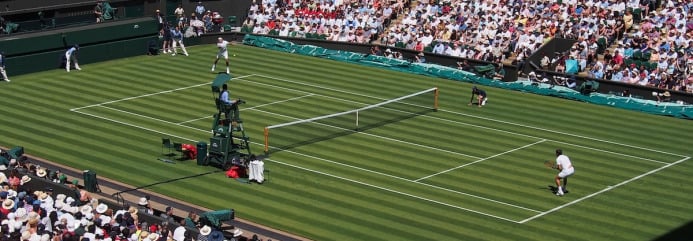Tennis Best Bets & Predictions
Free Tennis Picks
Free Tennis Picks
Tennis Betting
While soccer is the most popular sport in the world, tennis may be up there in terms of the number of countries where it is popular as well. With the tennis calendar featuring events on just about every continent, and with the top players in the world coming from all over the globe, there is worldwide interest in tennis on a consistent basis. And thanks to that interest, and the opportunity to make money betting on tennis, we cover tennis betting markets almost all year long.
Types of Tennis Bets
There are tons of different tennis bets that can be made on every match during every tournament. But our tennis betting experts typically zero in on a few mainstream betting markets, including the following types of bets that are easy to find both before and during most matches throughout the season.
Moneyline Bets
The goal of moneyline bets in tennis could not possibly be simpler, as the objective is to successfully predict which player will win each tennis match. For example, a bettor may see the following moneyline odds for a match.
Novak Djokovic -120
Rafael Nadal EVEN
In that scenario, bettors would need to wager $120 on Novak Djokovic to turn a profit of $100. Meanwhile, bettors would only need to wager $100 to win $100 on Nadal.
It is important to remember that some players will have better chances to win depending on what surface a match is being contested on. Those surface differences are baked into the odds for each match, but should be taken into account nonetheless.
Additionally, bettors should read the house rules for tennis betting at each sportsbook they use, especially when betting on moneylines. Some sports betting sites void wagers where a trailing player has to retire due to injury, while others still grade those retirements as losses. That can have a huge impact on a bettor’s profitability when betting tennis moneylines.
Spread Bets
In most sports, spread betting pertains solely to the amount of scoring done by each team or player. But in tennis, there are a couple of different ways that spread betting can be done. Bettors can wager on spreads related to service games won by each player, or sets won by each player, with the handicap being applied to one of those numbers or the other.
For example, a player can be favored by 3.5 service games over an opponent, while simultaneously being favored by 1.5 sets in the same match. Worth noting with this type of betting is the fact that the loser of a match can cover either of these lines even when they lose a match, depending on the number of service games and sets won by each side.
Over/Under Bets
Over/under betting works similarly to spread betting in tennis, as bettors can wager on the number of service games played in a match or the number of sets played in a match. With this market, sportsbooks will set a number of service games and sets to be played in the match. From there, it is up to bettors to select whether they think the actual number of games or sets will go over or under that total.
This market can be a little tricky to nail down, as there are so many factors that can impact whether a match is longer or shorter than anticipated. But bettors who can get a handle on how each tennis player approaches their matches and can figure out when to play either side of this market can do very well betting on tennis.
Tennis Coverage All Season Long
One of the great things about tennis betting compared to most other sports is the fact that there is tennis on for nearly all of each year. The tennis season starts right around the start of each new year, and ends with the annual tour finals in November. That means plenty of chances to place bets on dozens upon dozens of tournaments.
Here at ATS, we cover everything from the biggest Grand Slam events of the year, all the way down to the smaller level events on the tennis calendar. Everything from the Australian Open, US Open, French Open and Wimbledon, to Masters 1000 events, and all the way down to 500 and 250 level tournaments are covered right here on a regular basis.














